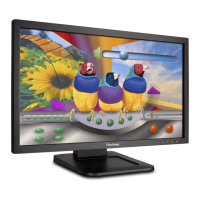
Do you have a question about the ViewSonic TD2220 and is the answer not in the manual?
| Full HD | Yes |
|---|---|
| Dimensions (WxDxH) | 511 x 66 x 310 mm |
| Display viewable area (HxV) | 477.5 x 269.2 mm |
| Dimensions (W x D x H) with stand | 511 x 240 x 635 mm |
| Mean time between failures (MTBF) | 40000 h |
| 3D | No |
| Aspect ratio | 16:9 |
| Screen shape | Flat |
| Backlight type | W-LED |
| Display diagonal | 21.5 \ |
| Touchscreen type | Tabletop |
| Display brightness | 200 cd/m² |
| Display technology | LED |
| Viewing angle, vertical | 160 ° |
| Contrast ratio (dynamic) | 20000000:1 |
| Contrast ratio (typical) | 1000:1 |
| Display diagonal (metric) | 54.61 cm |
| Viewing angle, horizontal | 170 ° |
| Digital vertical frequency | 50 - 76 Hz |
| Digital horizontal frequency | 24 - 83 kHz |
| Certification | CE, CB, BSMI, PSB, SASO, C-tick, e-standby, KC, UL/cUL, FCC-B (ICES003), UL CoC, Mexico Energy, GOST-R/Hygienic, UkrSEPRO, TCO 5.2, Erp, CCC, China Energy, EPEAT Silver, WEEE, RoHS, SVHC |
| Product color | Black |
| Compatible operating systems | Windows 7 |
| Audio input | 1 |
| USB Type-A downstream ports quantity | 2 |
| Tilt angle range | 20 - 5 ° |
| Panel mounting interface | 100 x 100 mm |
| AC input voltage | 110 - 240 V |
| Power supply type | AC |
| AC input frequency | 50 - 60 Hz |
| Power consumption (typical) | 26 W |
| Power consumption (PowerSave) | 18 W |
| Operating temperature (T-T) | 0 - 40 °C |
| Operating relative humidity (H-H) | 20 - 90 % |
| Package weight | 6450 g |
| RMS rated power | 4 W |
| Sustainability certificates | ENERGY STAR |
| Depth (with stand) | 240 mm |
|---|---|
| Width (with stand) | 511 mm |
| Height (with stand) | 635 mm |
| Weight (with stand) | 4920 g |
| Weight (without stand) | 3960 g |
Details compliance with FCC rules for digital devices in the United States.
States compliance with Canadian standards for digital apparatus.
Information regarding compliance with European EMC and Low Voltage Directives.
Comprehensive safety precautions for operating the LCD display to prevent hazards and damage.
Step-by-step instructions for connecting cables, installing drivers, and initial setup.
Guide to configuring resolution and refresh rate for optimal picture quality and reduced eye strain.
Step-by-step guide to adjust OSD settings like contrast, brightness, and position for optimal display.
Steps to diagnose and resolve issues related to no power or no screen image.
Details on what the warranty covers, its duration, and specific conditions that are not covered.
Instructions on how to get technical support and service under the product warranty.
